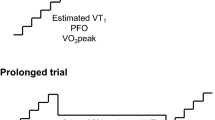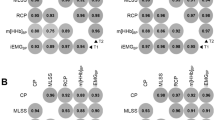Abstract
This study examined the magnitude of the oxygen uptake slow component \((\dot{V}\hbox{O}_{2}\; \hbox{SC})\) during heavy exercise when preceded by heavy knee extension (KE) exercise. Nine males (26.6 ± 1.7 years, ±SE) performed repeated bouts of heavy exercise, each lasting 6 min with 6 min of recovery. Cycling–cycling trials (CYC1, CYC2) involved step transitions to a workrate corresponding to 50% of the difference between peak \(\dot{V}\hbox{O}_{2}\) and the lactate threshold (Δ 50%). During bilateral KE-cycling trails (KE, CYC3), KE was performed at an intensity requiring twofold greater muscle activation relative to CYC1 followed by a cycling transition to Δ 50%. \(\dot{V}\hbox{O}_{2}\) was measured breath-by-breath and was modeled using three exponentials to determinate the amplitudes (A 2′, A 3′) and time constants (τ 2, τ 3) of the primary phase and \(\dot{V}\hbox{O}_{2}\) SC. Electromyography (EMG) recorded from the vastus lateralis and medialis was averaged and reported relative to maximal voluntary contraction (%MVC). EMG was higher (p < 0.05) during KE (37.6 ± 8.1 %MVC) than CYC1 (20.8 ± 1.9 %MVC), CYC2 (21.6 ± 5.7 %MVC) and CYC3 (19.8 ± 6.3 %MVC). The amplitude of the \(\dot{V}\hbox{O}_{2}\) SC was lower (p < 0.05) in CYC2 (197 ± 120 ml min−1) and CYC3 (163 ± 51 ml min−1) compared to CYC1 (325 ± 126 ml min−1). No difference in \(\dot{V}\hbox{O}_{2}\) SC was observed between CYC2 and CYC3. Although the activation of additional motor units during KE exercise reduced the amplitude of the \(\dot{V}\hbox{O}_{2}\) SC, the decrease was similar to that observed following heavy cycling exercise. Thus, the activation of motor units in excess of those required for the activity does not alter the\(\dot{V}\hbox{O}_{2}\) response during a subsequent bout of exercise.



Similar content being viewed by others
References
Akima H, Kinugasa R, Kuno S (2005) Recruitment of the thigh muscles during sprint cycling by muscle functional magnetic resonance imaging. Int J Sports Med 26:245–252
Andersen P, Adams RP, Sjogaard G, Thorboe A, Saltin B (1985) Dynamic knee extension as model for study of isolated exercising muscle in humans. J Appl Physiol 59:1647–1653
Ball-Burnett M, Green HJ, Houston ME (1991) Energy metabolism in human slow and fast twitch fibres during prolonged cycle exercise. J Physiol 437:257–267
Barstow TJ, Jones AM, Nguyen PH, Casaburi R (1996) Influence of muscle fiber type and pedal frequency on oxygen uptake kinetics of heavy exercise. J Appl Physiol 81:1642–1650
Borrani F, Candau R, Millet GY, Perrey S, Fuchslocher J, Rouillon JD (2001) Is the \(\dot{V}\hbox{O}_{2}\) slow component dependent on progressive recruitment of fast-twitch fibers in trained runners? J Appl Physiol 90:2212–2220
Bouckaert J, Jones AM, Koppo K (2004) Effect of glycogen depletion on the oxygen uptake slow component in humans. Int J Sports Med 25: 351–356
Burnley M, Jones AM, Carter H, Doust JH (2000) Effects of prior heavy exercise on phase II pulmonary oxygen uptake kinetics during heavy exercise. J Appl Physiol 89:1387–1396
Burnley M, Doust JH, Ball D, Jones AM (2002a) Effects of prior heavy exercise on \(\dot{V}\hbox{O}_{2}\) kinetics during heavy exercise are related to changes in muscle activity. J Appl Physiol 93:167–174
Burnley M, Doust JH, Jones AM (2002b) Effects of prior heavy exercise, prior sprint exercise and passive warming on oxygen uptake kinetics during heavy exercise in humans. Eur J Appl Physiol 87: 424–432
Carter H, Pringle JS, Boobis L, Jones AM, Doust JH (2004) Muscle glycogen depletion alters oxygen uptake kinetics during heavy exercise. Med Sci Sports Exerc 36:965–972
Cleuziou C, Perrey S, Borrani F, Lecoq AM, Courteix D, Germain P, Obert P (2004) \(\dot{V}\hbox{O}_{2}\) and EMG activity kinetics during moderate and severe constant work rate exercise in trained cyclists. Can J Appl Physiol 29:758–772
Crow MT, Kushmerick MJ (1982) Chemical energetics of slow- and fast-twitch muscles of the mouse. J Gen Physiol 79:147–166
Deley G, Millet GY, Borrani F, Lattier G, Brondel L (2006) Effects of two types of fatigue on the \(\dot{V}\hbox{O}_{2}\) slow component. Int J Sports Med 27:475–482
Endo MY, Kobayakawa M, Kinugasa R, Kuno S, Akima H, Rossiter HB, Miura A, Fukuba Y (2007) Thigh muscle activation distribution and pulmonary \(\dot{V}\hbox{O}_{2}\) kinetics during moderate, heavy, and very heavy intensity cycling exercise in humans. Am J Physiol Regul Integr Comp Physiol 293:R812–R820
Ericson MO, Nisell R, Arborelius UP, Ekholm J (1985) Muscular activity during ergometer cycling. Scand J Rehabil Med 17:53–61
Gerbino A, Ward SA, Whipp BJ (1996) Effects of prior exercise on pulmonary gas-exchange kinetics during high intensity exercise in humans. J Appl Physiol 80:99–107
Gonzales JU, Scheuermann BW (2007) Prior heavy exercise increases oxygen cost during moderate exercise without associated change in surface EMG. J Electromyogr Kinesiol (in press)
Gurd BJ, Scheuermann BW, Paterson DH, Kowalchuk JM (2005) Prior heavy-intensity exercise speeds \(\dot{V}\hbox{O}_{2}\) kinetics during moderate-intensity exercise in young adults. J Appl Physiol 98:1371–1378
Gurd B, Peters SJ, Heigenhauser GJ, LeBlanc PJ, Doherty TJ, Paterson DH, Kowalchuk JM (2006) Prior heavy exercise elevates pyruvate dehydrogenase activity and speeds O2 uptake kinetics during subsequent moderate-intensity exercise in healthy young adults. J Physiol 577:985–996
Hansen JE, Sue DY, Oren A, Wasserman K (1987) Relation of oxygen uptake to work rate in normal men and men with circulatory disorders. Am J Cardiol 59:669–674
Hogan MC, Gladden LB, Kurdak SS, Poole DC (1995) Increased [lactate] in working dog muscle reduces tension development independent of pH. Med Sci Sports Exerc 27:371–377
Jones AM, Wilkerson DP, Burnley M, Koppo K (2003) Prior heavy exercise enhances performance during subsequent perimaximal exercise. Med Sci Sports Exerc 35:2085–2092
Jones AM, Berger NJ, Wilkerson DP, Roberts C (2006) Effects of ‘priming’ exercise on pulmonary O2 uptake and muscle deoxygenation kinetics during heavy-intensity cycle exercise in the supine and upright positions. J Appl Physiol 101:1432–1441
Kent-Braun JA (1999) Central and peripheral contributions to muscle fatigue in humans during sustained maximal effort. Eur J Appl Physiol 80:57–63
Koga S, Poole DC, Shiojiri T, Kondo N, Fukuba Y, Miura A, Barstow TJ (2005) Comparison of oxygen uptake kinetics during knee extension and cycle exercise. Am J Physiol 288:R212–R220
Krustrup P, Söderlund K, Mohr M, Bangsbo J (2004a) The slow component of oxygen uptake during intense, sub-maximal exercise in man is associated with additional fibre recruitment. Pflügers Arch 447:855–866
Krustrup P, Söderlund K, Mohr M, González-Alonso J, Bangsbo J (2004b) Recruitment of fibre types and quadriceps muscle portions during repeated, intense knee-extensor exercise in humans. Pflügers Arch 449:56–65
Löllgen H, Graham T, Sjogaard G (1980) Muscle metabolites, force, and perceived exertion bicycling at varying pedal rates. Med Sci Sports Exerc 12:345–351
MacDonald MJ, Pedersen PK, Hughson RL (1997) Acceleration of \(\dot{V}\hbox{O}_{2}\) kinetics in heavy submaximal exercise by hyperoxia and prior high-intensity exercise. J Appl Physiol 83:1318–1325
Perrey S, Scott J, Mourot L, Rouillon J-D (2003) Cardiovascular and oxygen uptake kinetics during sequential heavy cycling exercises. Can J Appl Physiol 28:283–298
Poole DC, Schaffartzik W, Knight DR, Derion T, Kennedy B, Guy HJ, Prediletto R, Wagner PD (1991) Contribution of exercising leg to the slow component of oxygen uptake kinetics in humans. J Appl Physiol 71:1245–1253
Poole DC, Gaesser GA, Hogan MC, Knight DR, Wagner PD (1992) Pulmonary and leg \(\dot{V}\hbox{O}_{2}\) during submaximal exercise—implications for muscular efficiency. J Appl Physiol 72:805–810
Poole DC, Barstow TJ, Gaesser GA, Willis WT, Whipp BJ (1994) \(\dot{V}\hbox{O}_{2}\) slow component: physiological and functional significance. Med Sci Sports Exerc 26:1354–1358
Pringle JSM, Doust JH, Carter H, Tolfrey K, Campbell IT, Jones AM (2003a) Oxygen uptake kinetics during moderate, heavy and severe intensity “submaximal” exercise in humans: the influence of muscle fibre type and capillarisation. Europ J Appl Physiol 89:289–300
Pringle JSM, Doust JH, Carter H, Tolfrey K, Jones AM (2003b) Effect of pedal rate on primary and slow-component oxygen uptake responses during heavy-cycle exercise. J Appl Physiol 94:1501–1507
Reid RW, Foley JM, Jayarama RC, Prior BM, Meyer RA (2001) Effect of aerobic capacity on the T2 increase in exercised skeletal muscle. J Appl Physiol 90:897–902
Richardson RS, Poole DC, Knight DR, Kurdak SS, Hogan MC, Grassi B, Johnson EC, Kendrick KF, Erickson BK, Wagner PD (1993) High muscle blood flow in man: is maximal O2 extraction comprimised? J Appl Physiol 75:1911–1916
Richardson RS, Frank LR, Haseler LJ (1998) Dynamic knee-extensor and cycle exercise: functional MRI of muscular activity. Int J Sports Med 19:182–187
Robach P, Biou D, Herry JP, Deberne D, Letournel M, Vaysse J, Richalet JP (1997) Recovery processes after repeated supramaximal exercise at the altitude of 4,350 m. J Appl Physiol 82:1897–1904
Rossiter HB, Ward SA, Kowalchuk JM, Howe FA, Griffiths JR, Whipp BJ (2002) Dynamic asymmetry of phosphocreatine concentration and O2 uptake between on- and off-transients of moderate- and high-intensity exercise in humans. J Physiol 541:991–1002
Sahlin K, Tonkonogi M, Söderlund K (1998) Energy supply and muscle fatigue in humans. Acta Physiol Scand 162:261–266
Sahlin K, Sorensen JB, Gladden LB, Rossiter HB, Pedersen PK (2005) Prior heavy exercise eliminates \(\dot{V}\hbox{O}_{2}\) slow component and reduces efficiency during submaximal exercise in humans. J Physiol 564:765–773
Sargeant AJ, Dolan P (1987) Effect of prior exercise on maximal short-term power output in humans. J Appl Physiol 63:1475–1480
Sargeant, Rademaker ACHJ (1996) Human muscle fibre types and mechanical efficiency during cycling. In: Steinacker JM, Ward SA (eds) The physiology and pathophysiology of exercise tolerance. Plenum Press, New York, pp 247–251
Saunders MJ, Evans EM, Arngrimsson SA, Allison JD, Warren GL, Cureton KJ (2000) Muscle activation and the slow component rise in oxygen uptake during cycling. Med Sci Sports Exerc 32:2040–2045
Scheuermann BW, Hoelting BD, Noble ML, Barstow TJ (2001) The slow component of O2 uptake is not accompanied by changes in muscle EMG during repeated bouts of heavy exercise. J Physiol 531: 245–256
Scheuermann BW, Bell C, Paterson DH, Barstow TJ, Kowalchuk JM (2002a) Oxygen uptake kinetics for moderate intensity exercise are speeded in older humans by prior heavy intensity exercise. J Appl Physiol 92:609–616
Scheuermann BW, Tripse McConnell JH, Barstow TJ (2002b) EMG and oxygen uptake responses during slow and fast ramp exercise in humans. Exp Physiol 87:91–100
Shinohara M, Moritani T (1992) Increase in neuromuscular activity and oxygen uptake during heavy exercise. Ann Physiol Anthrop 11: 257–262
Shoemaker JK, Hodge L, Hughson RL (1994) Cardiorespiratory kinetics and femoral blood velocity during dynamic knee extension exercise. J Appl Physiol 77:2625–2632
Tordi N, Perrey S, Harvey A, Hughson RL (2003) Oxygen uptake kinetics during two bouts of heavy cycling separated by fatiguing sprint exercise in humans. J Appl Physiol 94:533–541
Wasserman K, Whipp BJ, Koyal SN, Beaver WL (1973) Anaerobic threshold and respiratory gas exchange during exercise. J Appl Physiol 35:236–243
Whipp BJ (1994) The slow component of O2 uptake kinetics during heavy exercise. Med Sci Sports Exerc 26:1319–1326
Whipp BJ, Ward SA, Lamarra N, Davis JA, Wasserman K (1982) Parameters of ventilatory and gas exchange dynamics during exercise. J Appl Physiol 52:1506–1513
Whipp, Lamarra N, Griffiths TL, Wasserman K (1983) Model implications of ventilatory dynamics during exercise. In: Whipp BJ, Wiberg DM (eds) Modelling and control of breathing. Elsevier, New York, pp 229–236
Wilkerson DP, Jones AM (2006) Influence of initial metabolic rate on pulmonary O2 uptake on-kinetics during severe intensity exercise. Respir Physiol Neurobiol 152:204–219
Acknowledgments
The investigators would like to thank the subjects who took part in this study. This study was funded in part by a University of Toledo DeArce Memorial Fellowship to B.W.S.
Author information
Authors and Affiliations
Corresponding author
Rights and permissions
About this article
Cite this article
Thistlethwaite, J.R., Thompson, B.C., Gonzales, J.U. et al. Prior heavy knee extension exercise does not affect \(\dot{V}\hbox{O}_{2}\) kinetics during subsequent heavy cycling exercise. Eur J Appl Physiol 102, 481–491 (2008). https://doi.org/10.1007/s00421-007-0614-5
Accepted:
Published:
Issue Date:
DOI: https://doi.org/10.1007/s00421-007-0614-5




